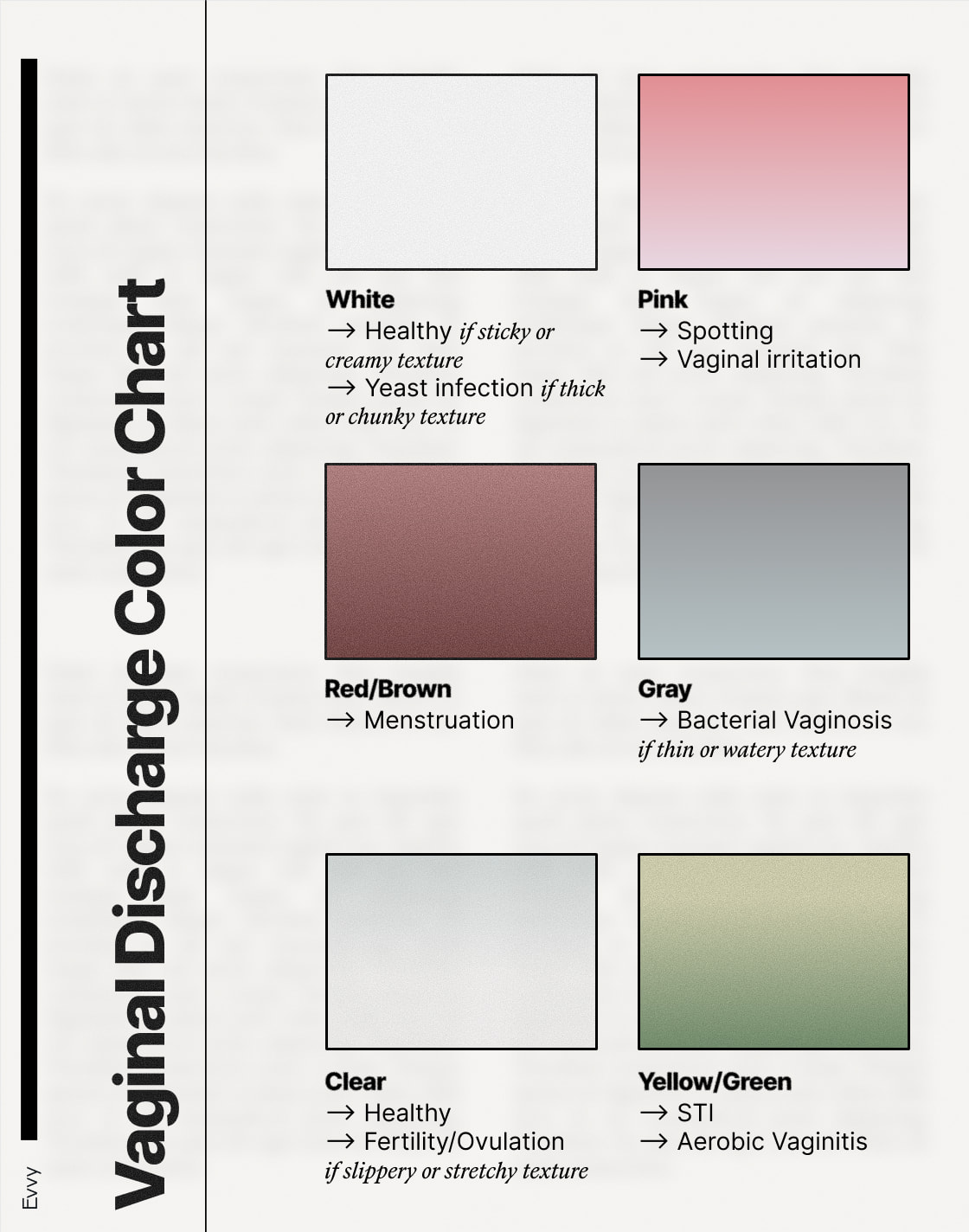

Discharge Color Meaning: What’s Normal?
Explore our discharge color chart to learn what clear, white, yellow, green, pink, brown, or gray discharge reveals about infections and hormonal changes.
Words by Olivia Cassano
Scientifically edited by Dr. Krystal Thomas-White, PhD
Medically reviewed by Dr. Kate Stewart, MD
Vaginal discharge plays a crucial role in keeping the vagina clean, lubricated, healthy, and free from infections. Discharge is literally proof that vaginas are self-cleaning organs. Moreover, discharge can also be a reliable indicator of your overall vaginal health, and the color of your discharge can often tell you what’s going on down there.
Vaginal discharge, also known as cervical mucus (or CM for short), is mainly composed of mucus produced by cells of the cervix (the opening of the uterus). What's considered "normal" can vary from person to person, but in general, normal vaginal discharge is usually clear, off-white, or white and doesn't have a strong odor. It may be thick, thin, stretchy, sticky, gooey, slippery, creamy, or watery. The consistency and color of discharge changes depending on many factors, like where you are in your menstrual cycle and whether you have an infection or are pregnant.
The amount of vaginal discharge can vary from person to person, too. Some people produce a lot of discharge, while others may notice very little. Both are normal and healthy. Additionally, some people may make more vaginal discharge around the time of ovulation, which typically occurs in the middle of the menstrual cycle.
What your vaginal discharge color means
It's good to keep in mind that everyone's vaginal discharge is different, so it might take a little while to figure out what's normal for you. You might not pay much attention to how your vaginal discharge looks unless you notice an unusual color.
While a funky-colored discharge might freak you out, it's probably nothing to worry about. However, in some cases, a different color could be a sign that something isn't quite right. Keep reading for a color-coded guide to discharge and what to do if you notice abnormal vaginal discharge.
In general, if your vaginal discharge is different from what it usually is, or if you have any other symptoms that are new or different from you, it’s best to see a healthcare provider.

1. Clear vaginal discharge
Clear vaginal discharge is usually a sign that everything is working just as it should. Whether it's thin and watery or thick and stretchy, clear discharge plays an important role in keeping your vaginal environment balanced, clean, and protected.
Normal vaginal health
Healthy vaginal discharge is often clear or clearish white, and its consistency can vary depending on where you are in your cycle, your hydration levels, and even your stress. It helps keep your vaginal canal clean by flushing out bacteria and dead cells, and it's a sign that your vaginal microbiome is doing its job. A little moisture is completely normal and essential for overall comfort and protection.
Unless it has a strong odor, causes itching, or comes with other unusual symptoms, like pain or irritation, clear discharge is nothing to worry about. It’s one of the best indicators that your vagina is in good health.
Ovulation
One of the most common times to see clear, stretchy, egg white-like discharge is during ovulation, typically around the middle of your cycle. As ovulation approaches, your body increases production of cervical mucus to create the perfect environment for sperm to survive and swim toward the egg. This discharge may be slippery, gooey, and can stretch between your fingers — a clear sign (pun intended) that you’re in your fertile window.
Many people use cervical mucus tracking as part of fertility awareness. This can help either increase the chances of getting pregnant or avoid pregnancy naturally (a method often called natural family planning). If you’re not seeing ovulation discharge and aren’t on hormonal birth control, it may be worth checking in with your provider to better understand your cycle.
If you are using hormonal birth control (like the pill, patch, or IUD), you might notice less or no ovulation discharge at all. That’s because these methods prevent ovulation, which in turn reduces the hormone-driven mucus changes you’d normally see mid-cycle.
Arousal
Not all clear discharge is linked to your cycle. Sometimes it’s your body’s response to sexual arousal. This is called arousal fluid, and it’s your body’s natural lubricant. When you're turned on, the Bartholin glands (located on either side of your vaginal opening) release this clear, slippery fluid to make sex more comfortable and pleasurable. You might notice it just before sex, during foreplay, or even afterward.
Arousal fluid is different from your everyday vaginal discharge, but both are totally normal. The key is knowing what’s typical for your body, so you can recognize when something feels off.
2. White and thick discharge
White discharge is one of the most common types of vaginal discharge, and in many cases, it’s completely normal. Its consistency and amount can change throughout your cycle, and sometimes, it can signal an underlying issue. Here’s how to tell the difference.
Normal if sticky or creamy
White discharge that is smooth, creamy, or slightly sticky is typically a normal part of your menstrual cycle. You’ll often notice it in the luteal phase, which is in the second half of your cycle, after ovulation and before your period starts. This type of discharge is usually odorless or has a very mild scent and may appear in your underwear or on toilet paper.
It also shows up in early pregnancy for many people. Rising hormone levels, especially progesterone, can lead to more milky white, lotion-like discharge (a completely normal response as your body adjusts to pregnancy). This increase in discharge helps protect against infections by maintaining a healthy vaginal environment.
As long as the discharge is not itchy, doesn’t smell strong or unpleasant, and isn’t clumpy or discolored, it’s most likely nothing to worry about.
Yeast infection if chunky
If your discharge is thick, white, and lumpy (like cottage cheese) and is accompanied by itching, burning, swelling, or redness, you're probably dealing with a yeast infection. Yeast infections are extremely common and happen when there's an overgrowth of Candida, a type of fungus that naturally lives in the vagina.
This type of discharge doesn’t usually have a strong smell, but the texture and irritation it causes are key signs. Yeast infections can be triggered by antibiotics, stress, hormonal changes, or even tight, non-breathable underwear. The good news is that they’re easily treatable with antifungal medications, which are available over the counter or by prescription.

Recurrent symptoms? Get Evvy's at-home vaginal microbiome test, designed by leading OB-GYNs.
3. Yellow discharge
Yellow discharge can mean different things depending on its shade, consistency, and whether it comes with other unusual symptoms. In many cases, it's completely harmless, but in others, it might be a sign of something that needs medical attention.
Oxidation or air exposure
Light yellow or pale yellow vaginal discharge is often totally normal, especially if it looks that way after sitting in your underwear for a bit. That yellow tint can happen when clear or white vaginal discharge oxidizes (is exposed to air) and dries. You might also notice a yellowish hue if your discharge mixes with urine, sweat, or even laundry detergent residue throughout the day. As long as it’s not accompanied by a strong odor, itching, or irritation, and it’s light in color, it’s likely just part of your body’s normal cycle.
STI
If your discharge is dark yellow, greenish-yellow, thick, or foul-smelling, it could be a sign of a sexually transmitted infection (STI) — especially chlamydia, gonorrhea, or trichomoniasis. These infections can also cause burning during urination, itching, pelvic pain, or abnormal bleeding, but here’s the tricky part: sometimes there are no symptoms at all.
That’s why routine STI testing is important, especially if you have new or multiple sexual partners, or if something about your discharge just feels “off.” If you’re worried, speak to your healthcare provider or take a comprehensive STI test, like Evvy’s Vaginal Health Test & Expanded PCR Panel, which screens for multiple infections discreetly from home.
4. Gray discharge
Gray vaginal discharge is one of the more noticeable types of vaginal discharge, and it’s almost always a sign of an infection. If you notice a grayish tint and a strong, fishy smell, it’s time to check in with your healthcare provider. Two of the most common causes are bacterial vaginosis (BV) and trichomoniasis, and while they’re often treatable, they can lead to complications if left unaddressed.
Bacterial vaginosis (BV)
Bacterial vaginosis is a common bacterial infection that occurs when there's an imbalance in your vaginal microbiome. Specifically, when harmful bacteria outnumber the beneficial Lactobacillus species that help keep your vagina healthy and slightly acidic. This shift can result in thin, gray vaginal discharge with a fishy odor, especially after sex.
BV is incredibly common, but it can still be frustrating. It’s not officially classed as an STI, but research shows that it can be transmitted sexually, and certain behaviors (like new or multiple sexual partners or douching) can increase your risk. BV may also cause mild irritation or burning during urination, but many people don’t notice symptoms beyond the discharge.
While BV is typically not dangerous, recurrent or untreated BV can increase your risk of more serious issues, like pelvic inflammatory disease (PID), complications during pregnancy, or increased vulnerability to STIs, including HIV.
Trichomoniasis
Trichomoniasis (or “trich”) is one of the most common STIs. It’s caused by a parasite called Trichomonas vaginalis, and like BV, it can produce gray or greenish-gray discharge with a foul or fishy smell. Other possible symptoms include itching, burning, discomfort during sex, or even spotting between periods. But here’s the catch: 70% of people with trich have no symptoms at all.
Because trich and BV can cause similar symptoms, they’re easy to confuse, and only testing can tell them apart. Thankfully, both are treatable with medication, but early detection is key to preventing recurrent infections and long-term complications like fertility issues or PID.
5. Green discharge
Green vaginal discharge is never a good sign, especially if it comes with other symptoms like itching, burning, an unusual smell, or pelvic pain. While it can be alarming, it’s your body’s way of signaling that something’s off. Several potential causes could be behind it, and it’s important to get checked out by a healthcare provider to identify and treat the issue properly.
STI
One of the most common causes of green vaginal discharge is a sexually transmitted infection (STI), particularly trichomoniasis, which can cause frothy, greenish-yellow vaginal discharge with a strong odor. Other STIs, like gonorrhea or chlamydia, may also lead to abnormal discharge, often accompanied by pelvic discomfort, burning during urination, or pain during sex. These infections are treatable, but they can lead to serious complications if left unaddressed, so early diagnosis is key.
Pelvic inflammatory disease
If an STI or vaginal infection travels upward into the reproductive organs, it can lead to pelvic inflammatory disease (PID), a serious condition that affects the uterus, fallopian tubes, and ovaries. PID can cause green or yellowish discharge along with fever, pelvic or abdominal pain, and pain during sex. If untreated, it may lead to infertility or chronic pelvic pain. Prompt medical attention is critical if PID is suspected.
Forgotten object
Sometimes, green discharge may be due to a forgotten object in the vagina, like an old tampon, condom, or menstrual cup. When something is left in place for too long, it can disrupt the vaginal microbiome and lead to infection. This can cause a strong-smelling, green or brown discharge, often with itching, irritation, or even fever. Removing the object and treating any infection is important to avoid further complications.
6. Pink or brown discharge
Pink or brown vaginal discharge can be surprising, but in most cases, it’s completely normal. The color usually comes from a small amount of blood mixing with vaginal fluids. Brown discharge often means the blood is older and has had time to oxidize, while pink vaginal discharge suggests fresher bleeding.
Spotting before or after your period
One of the most common reasons for brown or pink vaginal discharge is spotting right before or after your period. This can happen when your body is starting to shed (or finishing shedding) the uterine lining. The blood may be light and mix with vaginal mucus, resulting in pink discharge, or it may appear brown as older blood exits your body. This type of spotting is usually nothing to worry about, and just a normal part of your cycle.
Ovulation or implantation bleeding
Some people experience light pink or brown spotting around ovulation, typically mid-cycle. This is caused by a brief drop in estrogen or by the follicle releasing an egg, which can cause a bit of uterine lining to shed. It's harmless and not everyone notices it.
If you’re trying to conceive, you might also notice implantation bleeding — light pink or brown vaginal discharge that happens when a fertilized egg attaches to the uterine lining, usually six to 12 days after ovulation. It’s one of the earliest signs of pregnancy and often lasts just a day or two.
Cervical irritation
Sometimes, pink discharge shows up after penetrative sex, a pelvic exam, or a Pap smear. This can happen if your cervix gets slightly irritated or inflamed, especially if you’re pregnant, have a cervical infection, or are using hormonal birth control. The discharge might be light pink and only last a short time. Still, if it happens frequently or is accompanied by other symptoms like pain or odor, it’s a good idea to get checked.
Rare: Cervical cancer
In very rare cases, pink or bloody discharge can be a sign of cervical cancer. This type of discharge may appear unexpectedly — between periods, after sex, or after menopause — and is often watery or foul-smelling. If you're noticing unexplained pink discharge, especially if it happens more than once or comes with other symptoms (like pelvic pain or bleeding after sex), talk to your healthcare provider. Early detection matters.
When should I be concerned about the color of my discharge?
The general rule of thumb is to see your healthcare provider anytime you notice a drastic change in your vaginal discharge that is unusual for you. Tracking the color and consistency of your discharge can be incredibly helpful and makes it that much easier to spot when something isn’t quite right.
You should see your healthcare provider if you ever notice a strange color or smell in your vaginal discharge that is unusual for you or if you experience any vaginal itching, burning, or pain. Also, if you have changes in bleeding, it’s also wise to get checked out.
Your doctor will probably perform a pelvic exam and look at your vagina and vulva. They might also take a sample of your discharge with a swab and test it in a lab to check for a bacterial infection. If you prefer, you can request to do a self-swab or urine test, depending on your healthcare provider.
Noticing a change in the color of your vaginal discharge? Evvy’s at-home Vaginal Health Test pinpoints the cause by detecting 700+ bacteria, fungi, and STIs like chlamydia and trichomoniasis — all from one simple swab. Get clear results in just 1–3 days, plus access personalized treatment prescribed by a licensed provider.
FAQs
What color is UTI discharge?
Since a urinary tract infection (UTI) is an infection of the urinary tract (kidneys, ureters, bladder, and urethra), it doesn't affect your vaginal discharge (which is produced by the cervix and vagina). A UTI can, however, cause cloudy or dark pee, along with other trademark symptoms like a burning sensation and the need to pee frequently.
Is light yellow discharge normal?
Yes, yellow vaginal discharge can be perfectly normal. It’s usually healthy and often turns pale yellow after exposure to oxygen. You should only be concerned about yellow discharge if it’s unusual for you or if it has a strong and unpleasant smell accompanied by other symptoms like itching, burning, or pelvic pain.
What does thin milky white discharge mean?
Milky white vaginal discharge that doesn’t have a strong or unpleasant smell is perfectly normal. You might notice it at the end of your cycle, leading up to your period. That said, milky white vaginal discharge can also be an early symptom of pregnancy, so if you notice a lot of milky white vaginal discharge that is unusual for your body, it’s better to be safe than sorry and call your healthcare provider.
What color discharge should I worry about?
Normal vaginal discharge can range from clear to milky or slightly pale yellow, and the color can vary based on where you are in your cycle. But if you notice discharge that is gray, green, or dark yellow, it’s likely a sign of infection. Aside from a strange color, abnormal discharge may also have a watery, thick, or frothy consistency and have a fishy or foul odor.
What color is my discharge if I am pregnant?
During pregnancy, it's normal to have vaginal discharge that ranges from clear to milky white. At the end of your pregnancy, you might also notice streaks of pink jelly-like mucus called a "show", which happens when the mucus plug in your cervix comes away. This is a sign that labor is about to start.
What is the healthiest color of discharge?
The healthiest color of vaginal discharge is usually clear or milky white. This type of discharge is completely normal and is part of your vagina’s natural way of staying clean and maintaining a healthy balance of bacteria. Throughout your menstrual cycle, the consistency and amount of discharge can vary, but as long as it's clear or white and doesn’t have a strong odor or cause irritation, it's a good sign that everything is working as it should be.
What color is STI discharge?
Abnormal discharge caused by a sexually transmitted infection (STI) can vary in color, depending on the type of STI. Common signs include yellow or green discharge, which may indicate infections like gonorrhea or trichomoniasis. This discharge might also be thicker, frothy, or accompanied by a foul odor. In some cases, discharge related to an STI can be white and thick, similar to a yeast infection. If you notice any unusual changes in the color, consistency, or smell of your discharge, it’s important to see a healthcare provider or take an STI test.





